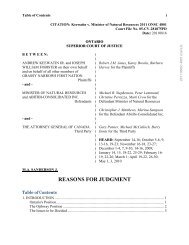Cronk v. Canadian General Insurance Co., 1995 CanLII 814 (ON CA)
Cronk v. Canadian General Insurance Co., 1995 CanLII 814 (ON CA)
Cronk v. Canadian General Insurance Co., 1995 CanLII 814 (ON CA)
You also want an ePaper? Increase the reach of your titles
YUMPU automatically turns print PDFs into web optimized ePapers that Google loves.
granting the respondent's request for 20 months' notice by re-examining the<br />
emphasis to be placed on character of employment and its factual underpinning.<br />
MacPherson J. gave three reasons for rejecting C.G.I.'s submission that a<br />
distinction must be drawn between the length of notice available for clerical<br />
employees and management employees. First, C.G.I. offered no evidence to<br />
support its argument that non-management employees need less time to find a job.<br />
Second, MacPherson J. considered Ellen Mole's Butterworths Wrongful Dismissal<br />
Practice Manual (Scarborough, Ont.: Butterworths, 1984, with regular looseleaf<br />
updates). It contained six Ontario cases between 1980 and 1994 in which senior<br />
management employees were awarded notice periods of 20 and 21 months. He<br />
cited her finding that the average period of post-dismissal unemployment was only<br />
nine and one third months for these employees. Ms <strong>Cronk</strong> had been unemployed<br />
for eight months at the time that the motion was heard and<br />
MacPherson J. considered her future employment prospects to be bleak. He thus<br />
concluded that the traditional rationale for granting senior managerial employees<br />
longer notice periods on the assumption that they had greater difficulty in securing<br />
alternative employment was not borne out by the evidence. Third, MacPherson J.<br />
concluded that higher education and specialized training correlate directly with<br />
increased access to employment. Ms <strong>Cronk</strong> had only a high school education.<br />
Accordingly, he found that Ms <strong>Cronk</strong> would have a harder, not an easier, time of<br />
finding employment than a senior executive. He awarded Ms <strong>Cronk</strong> 20 months'<br />
notice.<br />
MacPherson J. supported his conclusion that Ms <strong>Cronk</strong> should be entitled to the<br />
same notice period as that given to management employees of the same age and<br />
years of service by reference to two studies published by the <strong>Co</strong>uncil of Ontario<br />
Universities: The Financial Position of Universities in Ontario: 1994 and Facts<br />
and Figures: A <strong>Co</strong>mpendium of Statistics on Ontario Universities (1994). The<br />
latter study indicates that over a 10-year period the unemployment rate for high<br />
school graduates in Ontario ranged from 5.7 to 12.5 per cent. For university<br />
graduates, the range was from 1.6 to 5.1 per cent. In the year Ms <strong>Cronk</strong> was fired,<br />
the unemployment rate for university graduates was 4.2 per cent whereas for high<br />
school graduates it was 12.5 per cent.<br />
The appellant's position is that MacPherson J.'s three reasons for rejecting the<br />
importance of character of employment in determining the length of the notice<br />
period disclose error. With respect to the first reason given by MacPherson J., the<br />
appellant contends that it should not have been expected to lead evidence that the<br />
longer notice periods are reserved for supervisory or managerial employees given<br />
his belief that he could rely on the distinction as a principle of law. The appellant<br />
says it was essentially taken by surprise when MacPherson J. refused to accept as<br />
a "principle of law" that a clerical employee is generally entitled to a shorter notice
















